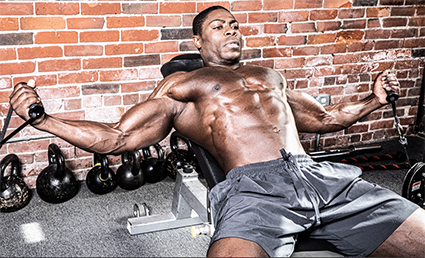The Building Perfect Mass Workout
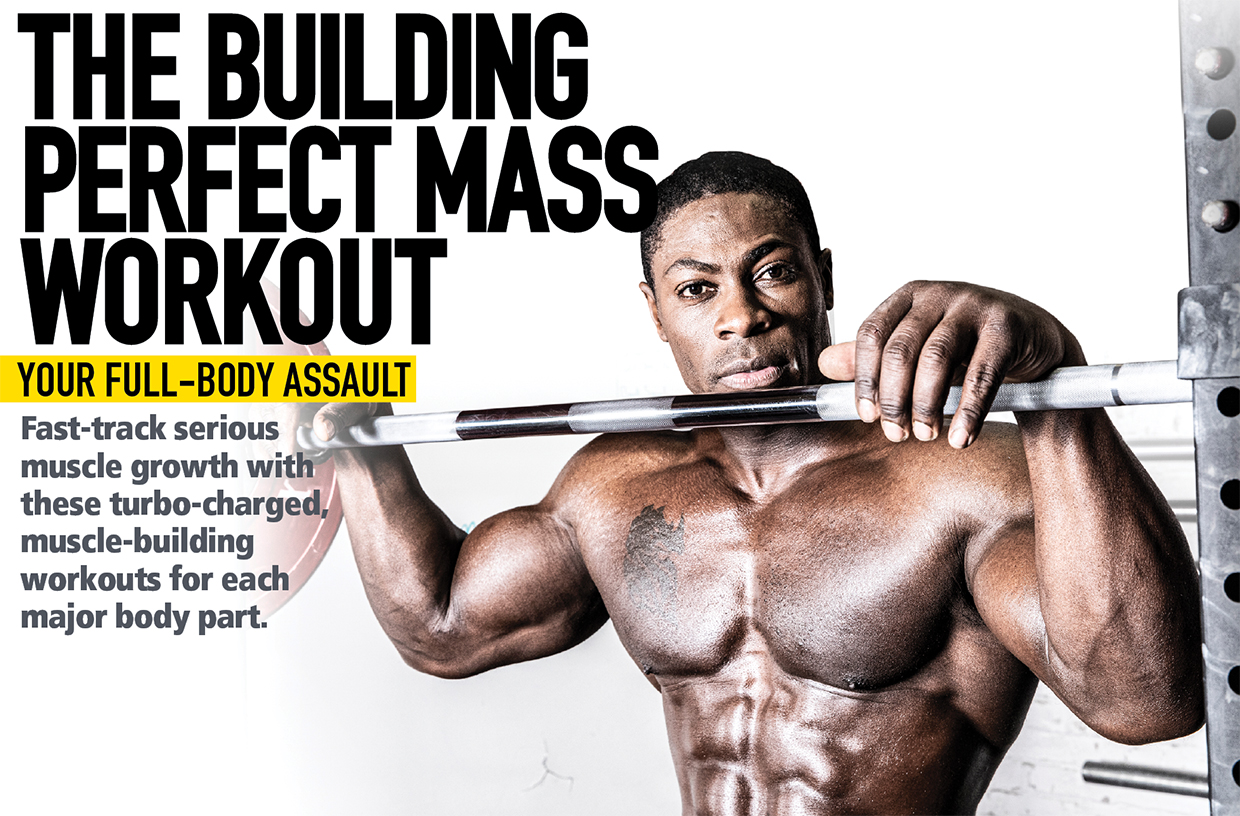
Fast-track serious muscle growth with these turbo-charged, muscle-building workouts for each major body part. Warning: These are challenging!
I don’t believe in magic—that is, fake promises that someone’s workout is the formula for getting big. I’m smarter and more experienced than that. I want proof!
With that in mind, I’m going to prove to you the ideal formula for building workouts—for each body part—that are ideal for maximizing hypertrophy. You don’t need to take my word for it because they’re all built on research in exercise science. With 25 years as a writer and editor for top bodybuilding magazines and websites in North America, if I can’t convince you that our approach is most effective.
I’ll show you a sample four-day split that’s ideal for building muscle. But these aren’t just ordinary workouts; rather, I’ve constructed them to be highly challenging to any intermediate to advanced lifter seeking to fast-track strength and size gains using the same exercises and principles I use in my training.
Remember, everything you do in the gym is done for a reason; that is, if you don’t know why you’re doing a movement, its place in your workout, and the volume and intensity you’re using, you should make it a point to understand why. Hopefully, this feature will give you that insight.
So, let’s fast-track muscle growth by creating workouts that optimize muscle building. Feel free to tinker with them based on equipment availability, movements that just don’t feel right, to target areas that may be lagging, or other personal factors. First, here’s an important review of how these workouts were designed.

How to Build a Great Mass Routine
What constitutes a mass-building routine that’s not just good but great? Actually, several factors must be considered, five of which have been studied and linked to muscle growth.1 Here they are, plus some other most important tips.
• Choose multi-joint moves early in your workout. Exercises such as the bench press, squat, bent-over row, and shoulder press involve more than a single pair of joints and therefore recruit more muscle groups, which allows you to lift heavier. That factor alone means they have a greater anabolic stimulus. As such, they should be done early in your workout when you’re fresh.
ª Use high volume. Maximizing muscle growth requires more than just choosing the right exercises and doing them in the right order. You must also do a sufficient number of total sets. This is where hitting a given muscle group from multiple angles can help optimize muscle size. The more advanced you are, the more volume you can handle, but note that it’s inversely related to frequency. That is, you hit that muscle group again somewhat less often.
• Use moderately heavy weights for moderate reps. When you’re training to optimize hypertrophy, science has shown the ideal number of repetitions to be 6 to 12. So, choose a weight with which you reach muscle failure within that rep range. That said, I like to skew it a bit so you’re going relatively heavier early in your training session, failing at 6 to 8 reps, when strength levels are highest, and using relatively lighter weights as fatigue sets in, reaching muscle failure at 10 to 12 toward the end of your training session. This approach allows you to build hypertrophy through all three mechanisms linked to muscle growth. It also gets you away from doing every exercise for 3 sets of 10.
• Take slightly longer rest periods on your heaviest sets and shorter ones toward the end of your workout. Optimal rest periods, at least as measured by hypertrophic response, are about 60 to 90 seconds between sets. On your very heaviest sets, however, add an extra 30 seconds of rest to ensure you’re more fully recovered, especially on leg day. Remember, the goal with hypertrophy training—as opposed to strength training—is to carry over lingering fatigue from one set to the next. By the end of your workout, the target body part should be thoroughly exhausted. And you’ll be progressively weaker as you train. That’s why you’re front-loading the workouts with the most challenging exercises with heavier-than-normal weights.

• Your final set for most exercises is a back-off set. After you finish your heavy sets for each movement, you’ll typically do one back-off set: You slightly lighten the weight and do a final set for a few extra reps than you completed on your previous set. Doing so not only helps pump the target muscle after you’ve done your heavy lifts but also allows you to change the relative intensity with which you do that exercise. Thus, you’re hitting the target muscle in a slightly different manner. Did I mention this approach has also been proven to provide a measurably better anabolic boost? Now I did.
• Use good form and controlled rep speed. These factors seem obvious, but even a well-designed mass-building routine won’t deliver if you aren’t using good form and maintaining control. Good form simply means making the target muscle do the work; minimizing the contribution of other muscle groups and controlling each rep also saves your joints. Strive to use a powerful motion (but not ballistic) on the concentric rep and control the negative by slowly lowering it. I like the negative to be slightly longer than the positive. Don’t forget, the negative rep is also considered part of the contraction, and there are designated techniques for strength building that specifically target it. The negative plays an important role in building size and strength, so don’t just focus on the lift.
• Keep track of overload. Muscles grow bigger by adapting to a training stimulus, but sooner or later, they’ll stop growing unless you keep increasing the overload. As you can do more reps with a given load, start adding weight. Keeping a log in which you track exercises, sets, load, and reps (and the order in which you do movements, because remember, building fatigue is progressive during your workout, and changing exercise order affects how much you can lift on a given movement), which will help you track your gains and be aware when your progress stalls. Don’t fall into a comfort zone that has you endlessly doing the same weight and sets-and-reps combinations, a sure recipe for spinning your wheels.
• Train to failure, but don’t overdo intensity boosters. Pushing past muscle failure on some sets aids muscle growth so long as it’s not overused. In the workouts, I identify particular sets that can be targeted for post-failure growth techniques.
• A good spotter will help boost your focus and push you further than you could achieve on your own. Many of the mass routines call for an occasional set of 2 or 3 forced reps, which you can achieve with the assistance of a good training partner.
• Warming up is not optional for top-level performance. If you’re not warming up and doing a few lightweight sets before handling more challenging weights, then you simply won’t be able to lift near the poundage you might normally achieve. Remember, a typical warm-up consists of five to 10 minutes of general cardio plus very lightweight sets of specific moves you’re about to do. Stretching is typically done at the end of your workout but can be done after your warm-up if you feel tight or want to loosen up a joint. Dynamic warm-ups are even better, which includes exercises such as walking knee raises.
There you have it—a road map of sorts for adding mass. Because you should already be familiar with exercise execution by now, I’m not going to detail how to do a movement. Even still, if you have any questions you can always Google it. Having a qualified personal trainer can also help you learn the more challenging moves.

Setting Your Training Split
The most important quality of a training split is that it works for you, taking into account your gym-time availability and outside commitments. The split below follows a two-days-on/one-day-off schedule so you rest every third day but still cover each muscle group every six days. One advantage of this program is that it builds in ample recovery and also allows you to easily move training/rest days backward or forward depending on whether you miss a workout, so you’re not always falling behind. It also includes a push day and a pull day so you’re less likely to overtrain some muscle groups. While you don’t have to follow this exact split, endeavor to build something like it. Remember, you want at least two days off each week.
THE MASS SPLIT:
DAY 1: Chest, triceps, abs
DAY 2: Back, biceps, calves
DAY 3: Rest
DAY 4: Shoulders, upper traps, abs
DAY 5: Quads/glutes, hams, calves
DAY 6: Rest
DAY 7: Cycle repeats

DAY 1: CHEST, TRICEPS, ABS
How We Chose the Best Exercises for Each Muscle Group
By now, you know multi-joint exercises are the best choices to start off your body-part routine because they engage the greatest degree of muscle mass, allowing you to push the heaviest loads, which then signals for greater release of anabolic hormones. It should come as no surprise, then, that some exercises are better than others at the beginning of your training session, and others are better at the tail end.
Today, exercise scientists measure muscular stimulation with the use of electromyography (EMG), an electrodiagnostic technique that gauges muscular electrical activity, helping you determine the best movements for each muscle group. In short, that allows us to make recommendations on the types of exercises you want to include in your training; those movements, then, should always be done at the outset of your training session when your energy levels are highest.
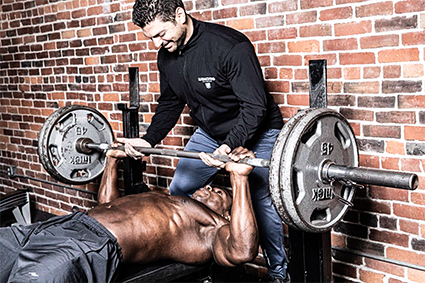
Chest: Bench Presses
Major muscles worked: pectoralis major and minor, anterior deltoid, triceps, serratus anterior.
The barbell bench press is thought to be the premier bench-press movement because you can generate the most power and therefore can press the most weight. The barbell is also easier to control than dumbbells, which allows you to put more energy into the push rather than balancing weights. A number of EMG studies have shown that the flat-bench barbell version better activates the pecs than incline presses, decline presses, or flyes, and it’s also superior for targeting the triceps brachii.”2,3
The biggest problem with the flat bench for most users is when you always start your workout with it. You become efficient with it, and that’s when marginal gains start to diminish. As with squats, try doing it first in 50 percent of your workouts, and with one of its many variations—whether a different bench angle or with an alternative piece of equipment such as dumbbells—the other half. That better allows you to build a fuller muscle.
Triceps: Weighted Dips
Major muscles worked: Triceps, anterior deltoid, upper pectoralis major.
Remember we said multi-joint exercises were better than single-joint ones? Given that, consider doing multi-joint triceps exercises including both close-grip bench presses and weighted dips (bench dips, parallel-bar dips, machine dips) first in your arm workout. It’s no surprise that published EMG evidence suggests that doing dips for triceps (when using the parallel bars, maintain a more vertical body position while restricting elbow flare) incurs a very high degree of triceps activation. Again, using added weight to ensure you fail within the target rep range of 6 to 12 is paramount.

Day 1: Chest, Triceps, Abs
 Exercise 2, 1
Exercise 2, 1
Chest
Incline Barbell Press
Sets: 4 Reps: 6, 63,4, 63,4, 105
Flat-Bench Dumbbell Press
Sets: 4 Reps: 83,4, 83,4, 105
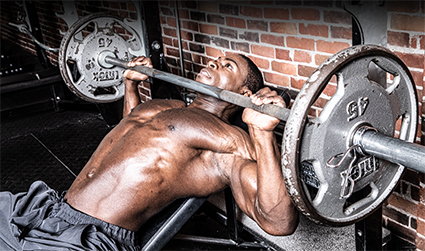 Machine Decline Press
Machine Decline Press
Sets: 3 Reps: 8, 84, 105
Incline-Bench Cable
Sets: 3 Reps: 10–12
superset with
Push-Up
3 Reps: to failure
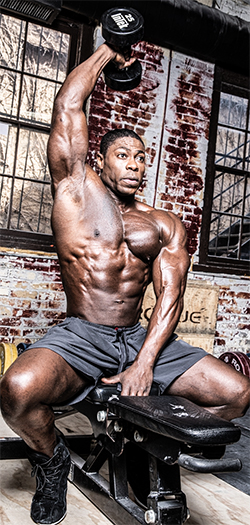 Triceps
Triceps
Close-Grip Bench Press
Sets: 4 Reps: 6–8, 6–84, 6–84, 105
Seated Machine Dip
Sets: 3 Reps: 8, 84, 105
Seated Overhead Dumbbell Extension
Sets: 3 Reps: 8–10, 8–104, 8–104
Overhand Press-Down
Sets: 2 Reps: 15
Abs
Hanging Leg Raise
Sets: 47 Reps: to failure6
Standing Cable Crunch
Sets: 37 Reps: 10, 10, 155
Floor Double Crunch
Sets: 37 Reps: to failure
1. Choose a weight with which you reach muscle failure by the target rep listed.
2. Doesn’t include warm-up sets; do as many warm-ups as you need but never take a warm-up set to muscle failure. (The warm-ups are the pyramid up.)
3. Take an extra 30 seconds of rest before this set.
4. Do 2–3 forced reps at the end of this set with assistance from a spotter.
5. This is a back-off set. Choose a slightly lighter weight on your last 1–2 set(s) for higher reps.
6. If you can’t do 8–10 reps, use the bent-knee version. Once you can do 15 reps with your knees bent, do the move with fairly straight legs.
7. Restrict rest periods to 30 seconds. If you need more time for recovery, extend it to 45 seconds.
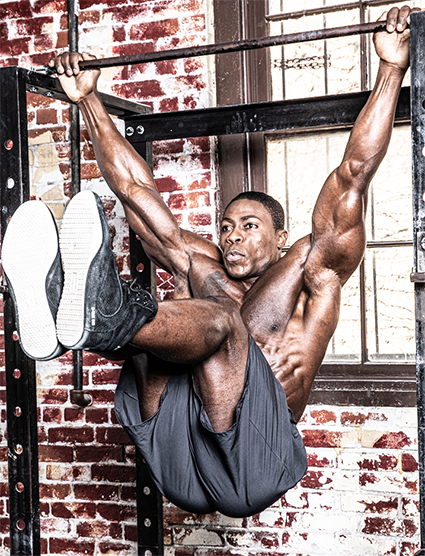
DAY 2: BACK, BICEPS, CALVES
Back: Bent-Over Barbell Rows
Major muscles worked: Latissimus dorsi, trapezius, rear delt, rhomboid, teres major, lower back, biceps.
EMG studies show hit the bent-over row hits the back musculature significantly and fairly evenly.4 Note the back isn’t a single muscle—i.e., just the lats—but rather, a collection of muscles. Because it allows you to handle very heavy loads, it’s a better choice than other back exercises, especially those done on machines. Remember that heavier loads mean greater risk of injury if you allow your back to round because it stresses the thoracic and lumbar discs. For sure it requires a strong lower back (erectors) to safely maintain proper position. The bent-over row can be done with an overhand grip (most common) or underhand grip; the latter recruits the biceps to a greater degree and hence may allow you to use more weight. Again, over time don’t always do it the same way.
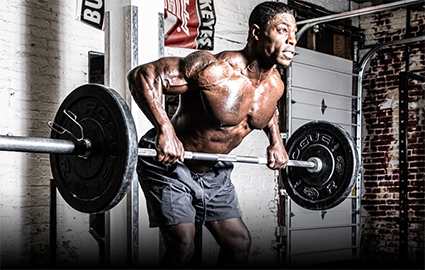
Overall: Barbell Deadlift
Major muscles worked: quads, hamstrings, glutes, traps, lats, erectors (lower back).
You can argue what the best overall mass-building movement is: barbell back squat or barbell deadlift. Since I already have the squat on this list on leg day, I’m going to add the conventional deadlift when training back.
Distinguish this multi-joint exercise from the single-joint Romanian, which is done on leg day for your upper hamstrings. Unlike the RDL, the conventional deadlift starts from a dead stop on the floor, which eliminates what’s called the stretch-reflex, which allows built-up energy to help as you more easily reverse direction when transitioning from the negative rep into the positive. Taking out elastic energy (by momentarily settling the bar on the floor) makes the movement more difficult! Another important key that trainers universally blow: You must go into a half-squat position rather than simply bending over. That, in fact, is what separates a multi-joint version from the single-joint RDL.
This is another very technical lift, which is beyond the scope of this article, but it’s another you need to practice under the eye of a good coach. If you continue to repeat bad form, you’re not only less likely to maximize growth but also setting yourself up for an injury. Deadlifts are usually trained on back day. When training for strength (i.e., doing lower reps), do this movement first in your workout when your energy is high. For reps with moderate weights, you can do them a bit later in your training session.
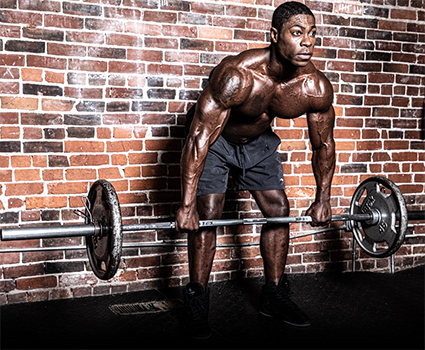
Biceps: Standing Curls
Major muscles worked: biceps, brachialis, brachioradialis, pronator teres.
Let’s start by saying the weighted chin-up (that’s the version with an underhand grip) scores highest on EMG tests of biceps movements. That multi-joint exercise is often thought of as a back exercise, but it unquestionably has a tremendous stimulus on the biceps—more so than overhand grip pull-ups. Remember, though, the movement must be weighted such that you fail in the 6- to 12-rep range; that is, if you can do more reps than that with the body-weight version, it becomes less effective unless you add a weight belt. If you can’t do at least 6 reps, use bands or the assisted pull-up machine.
Since the discussion here is on exercises that primarily target the biceps, we’ll focus on single-joint movements (that is, movement takes place only at the elbow joint). Using a barbell (or EZ-bar for wrist comfort) allows you to lift heavier weight than when doing other types of curls.
As you changed angles with your bench presses, you’ll want to change hand position with curls: An overhand grip also targets the brachioradialis on the elbow side of the forearm, and with a neutral (hammer) grip, you’ll also recruit the brachialis, which lies underneath the two-headed biceps. Even though it’s not visible, by making it grow, you increase the overall size of the arm.
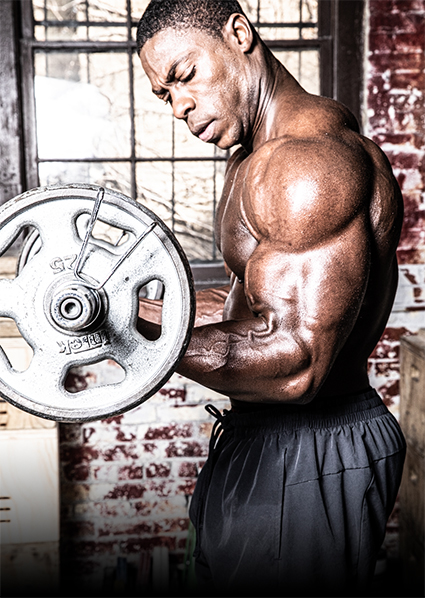
Day 2: Back, Biceps, Calves
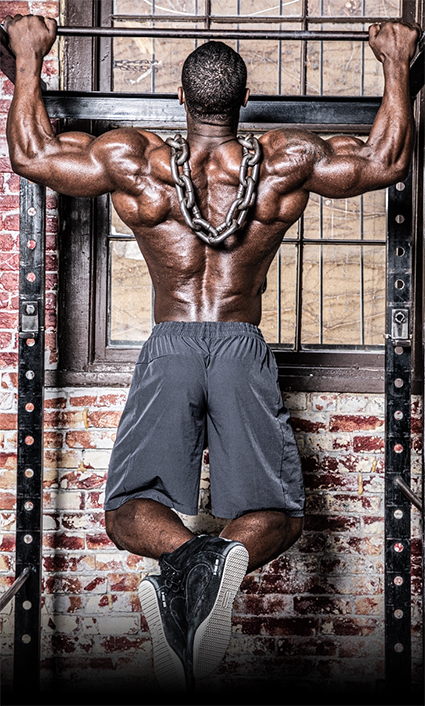 Exercise 2, 1
Exercise 2, 1
Back
Bent-Over Barbell Row or
Sets: 4 Reps: 6, 63, 83,5, 103,5
Deadlift
Sets: 4 Reps: 63, 63, 83,5, 103,5
Weighted Pull-Up or
Sets: 3 Reps: 8–104
Standing T-Bar Row
Sets: 3 Reps: 8–104
Wide-Grip Front Pull-Down
Sets: 3 Reps: 10, 104, 124,5
Close-Grip Seated Cable Row
Sets: 3 Reps: 10–12, 10–124, 10–124
Straight-Arm Pull-Down
Sets: 3 Reps: 12–15
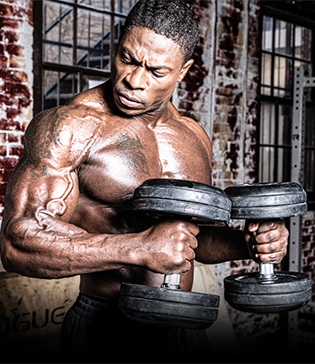 Biceps
Biceps
Standing Barbell Curl
Sets: 47 Reps: 6–84, 6–84, 8–105, 8–105
Incline Alternating Dumbbell Curl
Sets: 3 Reps: 8, 84, 104,5
One-Arm Preacher Curl
Sets: 3 Reps: 8–104
Dumbbell Hammer Curl
Sets: 2 Reps: 15
Calves
Donkey Calf Raise
Sets: 48 Reps: 12, 12, 205, 205
45-Degree Calf Raise
Sets: 48 Reps: 12, 12, 205, 205
Seated Calf Raise
Sets: 48 Reps: 15, 15, 255, 255
1. Choose a weight with which you reach muscle failure by the target rep listed.
2. Doesn’t include warm-up sets; do as many warm-ups as you need but never take a warm-up set to muscle failure. (The warm-ups are the pyramid up.)
3. Take an extra 30 seconds of rest before this set.
4. Do 2–3 forced reps at the end of this set with assistance from a spotter. On one-arm exercises, use your free hand to self-spot.
5. This is a back-off set. Choose a slightly lighter weight on your last 1–2 set(s) for higher reps.
6. In alternating workouts, do deadlifts or bent-over rows as your lead exercise. On the second exercise, if you started with deadlifts, do the standing T-bar row; if you did bent-over rows, do the weighted pull-up.
7. Do two sets with a grip just insider shoulder width and two sets a few inches outside shoulder width.
8. Restrict rest periods to 30 seconds. If you need more time for recovery, extend it to 45 seconds.

DAY 3: SHOULDERS, UPPER TRAPS, ABS
Shoulders: Overhead Presses
Major muscles worked: Middle and front delts, upper trapezius, triceps, upper pectoralis, serratus anterior.
You’ll get more bang for your buck with the standing barbell version over seated overhead presses, especially with dumbbells.5 Of note, any variation that pulls your elbows slightly forward (think overhead barbell presses, bringing the bar in front of your face) emphasizes the front delts a bit more than versions in which your upper arms go straight out to your sides (dumbbells, barbell behind your head). Where your elbows go with machines—directly out to slightly forward)—depends on the manufacturer and your hand position on the bars.
Seated overhead barbell presses restrict your ability to ability to generate a bit of body English—which you should use only sparingly toward the end of your set—and that means having to use a slightly lighter weight.

Day 4: Shoulders, Upper Traps, Abs
 Exercise2, 1
Exercise2, 1
Shoulders
Standing Overhead Barbell Press
Sets: 4 Reps: 6–8, 6–83,4, 8–103,4,5, 8–105
EZ-Bar Upright Row
Sets: 3 Reps: 8
Bent-Over Lateral Raise
Sets: 3 Reps: 8–10, 8–10, 10–125
Dumbbell Lateral Raise
Sets: 3 Reps: 8–10, 8–10, 10–125
Incline-Bench Barbell Front Raise
Sets: 3 Reps: 8–10, 8–10, 10–125

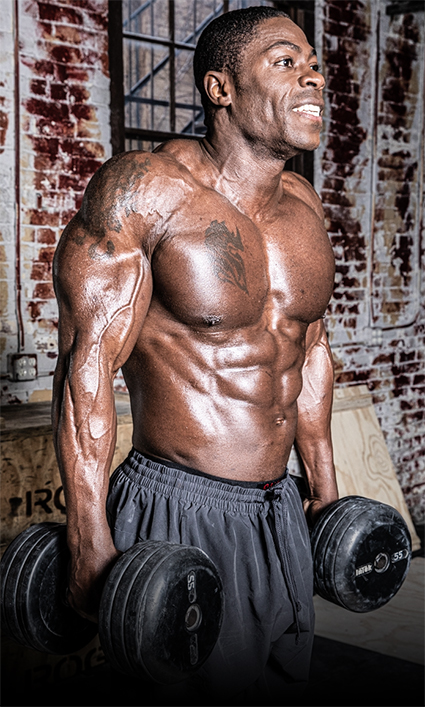 Upper Traps
Upper Traps
Dumbbell Shrug
Sets: 5 Reps: 8, 8, 8, 125, 125
Abs
Kneeling Cable Crunch
Sets: 47 Reps: 12, 12, 205, 205
Hanging Leg Raise
Sets: 37 Reps: to failure6
Floor Double Crunch
Sets: 37 Reps: to failure
1. Choose a weight with which you reach muscle failure by the target rep listed.
2. Doesn’t include warm-up sets; do as many warm-ups as you need but never take a warm-up set to muscle failure. (The warm-ups are the pyramid up.)
3. Take an extra 30 seconds of rest before this set.
4. Do 2–3 forced reps at the end of this set with assistance from a spotter. On one-arm exercises, use your free hand to self-spot.
5. This is a back-off set. Choose a slightly lighter weight on your last 1–2 set(s) for higher reps.
6. If you can’t do 8–10 reps, use the bent-knee version. Once you can do 15 reps with your knees bent, do the move with fairly straight legs.
7. Restrict rest periods to 30 seconds. If you need more time for recovery, extend it to 45 seconds.

DAY 4: LEGS
Quads/Glutes: Squats
Major muscles worked: Quadriceps, glutes, hamstrings.
The squat is the major lower-body mass builder, hitting all the major thigh and glute muscle groups. It’s a very challenging exercise from a technical standpoint. Learn both the back squat and front squat because they don’t hit the target muscles in the same manner: Front squats hit the quads more heavily as your center of gravity is more forward, which also requires you to keep a more upright body position; back squats focus on the hams and glutes more heavily, especially if you can squat to a thighs-parallel position.
The front version adds more stress on the knee, so you’ll want to ensure your knees are healthy.6 You might even consider alternating the front and back version in your leg workouts from one training session to the next as your primary movement.
It should be noted that while squats do stimulate the hamstrings, it’s primarily through controlling the negative rep of the movement. You’ll need to include dedicated hamstrings exercises to more thoroughly build the muscle group.
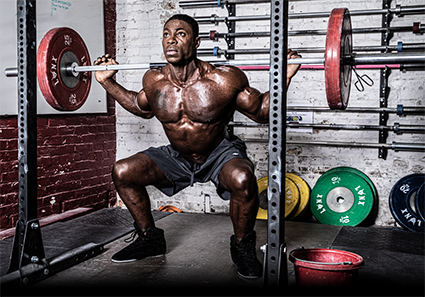
Hamstrings: Romanian Deadlifts
Major muscles worked: Hamstrings, gluteus maximus, spinal erectors (lower back).
The RDL beats out leg curls—both are single-joint ham movements—on the EMG.7 Because the hamstrings (a grouping of three muscles on the back of your thigh) cross the knee and hip joints, you need to include movements that work the hammies from both joints for maximal overall development, something many trainers fail to account for. What’s more, just about everyone includes knee-joint leg curls in their workouts already; if they’re not including RDLs, they’re leaving plenty of hamstring growth on the table. That’s another reason this upper-hamstring-targeted exercise is included here.
That said, no one—repeat, no one!—gets the form right at first, and many don’t even after several years. The main culprit: confusing it with its cousin, the conventional barbell deadlift. The latter is a multi-joint exercise (a great one at that; see back workout) in which you descend into a half-squat position; with the RDL, however, you just bend over (no half-squat!), pushing your hips rearward. With the RDL, the bar never, ever, ever, ever touches the floor! (Wonder what mistake many trainers make?) Don’t be one of them: Learn the difference and keep practicing until you get it perfect.
Neglecting your rear thighs isn’t just about aesthetics but also knee health: Your hamstrings need to be strong in relation to quad strength to stabilize your knees.
Day 5: Quads, Glutes, Hamstrings, Calves
Exercise2, 1
Quads/Glutes
Squat6or
Sets: 4 Reps: 6, 63,4, 83,4,5, 103,5
Front Squat
Sets: 4 Reps: 6, 63, 83,5, 103,5
Bulgarian Split Squat6 or
Sets: 3 Reps: 8–10
Leg Press
Sets: 3 Reps: 8–104
Hack Squat6 or
Sets: 3 Reps: 10, 104, 125
Smith-Machine Reverse Lunge
Sets: 3 Reps: 10, 10, 125
Leg Extension
Sets: 3-4 Reps: 10–12
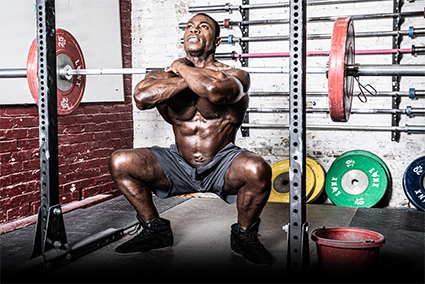
Hams
Romanian Deadlift
Sets: 4 Reps: 8–10, 8–10, 8–10, 10–125
Lying Leg Curl
Sets: 4 Reps: 8–10, 8–104, 8–104, 10–124,5
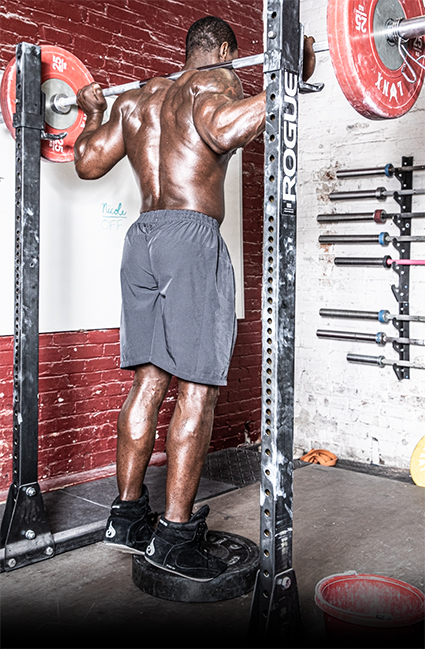 Calves
Calves
Standing Calf Raise
Sets: 47 Reps: 12, 12, 205, 205
45-Degree Calf Raise
Sets: 37 Reps: 12, 12, 205
Seated Calf Raise
Sets: 37 Reps: 15, 15, 255
1. Choose a weight with which you reach muscle failure by the target rep listed.
2. Doesn’t include warm-up sets; do as many warm-ups as you need but never take a warm-up set to muscle failure. (The warm-ups are the pyramid up.)
3. Take an extra 30 seconds of rest before this set.
4. Do 2–3 forced reps at the end of this set with assistance from a spotter.
5. This is a back-off set. Choose a slightly lighter weight on your last 1–2 set(s) for higher reps.
6. In alternating workouts, do squats/front squats as the leading exercise. On your second movement, also alternate leg presses and Bulgarian split squats, then the hack squat/Smith-machine reverse lunge on the third.
7. Restrict rest periods to 30 seconds. If you need more time for recovery, extend it to 45 seconds.
References
1. Kraemer WJ, Ratamess NA. Hormonal responses and adaptations to resistance exercise and training. Sports Med. 2005;35(4):339-61.
2. Barnett C, Kippers V, Turner P. Effects of variations of the bench-press exercise on the EMG activity of five shoulder muscles.
J Strength Cond Res. 1995;9(4):222-227.
3. Glass SC, Armstrong T. Electromyographical activity of the pectoralis muscle during incline and decline bench presses. J Strength Cond Res. 1997;11(3):163-167.
4. Fenwick CM, Brown SH, McGill SM. Comparison of different rowing exercises: trunk muscle activation and lumbar spine motion, load, and stiffness. J Strength Cond Res. 2009 Aug;23(5):1408-17.
5. Saeterbakken AH, Fimland MS. Effects of body position and loading modality on muscle activity and strength in shoulder presses. J Strength Cond Res. 2013 Jul;27(7):1824-31..
6. Gullett JC, Tillman MD, Gutierrez GM, Chow JW. A biomechanical comparison of back and front squats in healthy, trained individuals. J Strength Cond Res. 2009 Jan;23(1):284-92.
7. McAllister MJ, Hammond KG, Schilling BK, et al. Muscle activation during various hamstring exercises. J Strength Cond Res. 2014 Jun;28(6):1573-80.
8. Boeckh-Behrens WU, Beier P, Buskies W. (2001). Fitness Strength Training: The Best Exercises and Methods of Sport and Health. Rowholt paperback publishing house.
Photos: Dave Laus / Model: Kimani Victor
Click HERE to sign up for our free newsletter!


